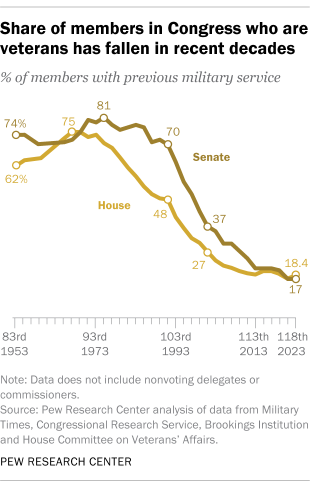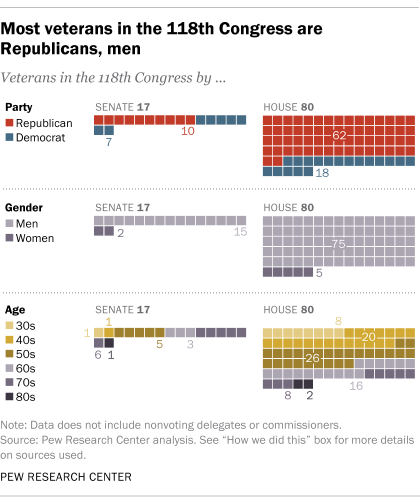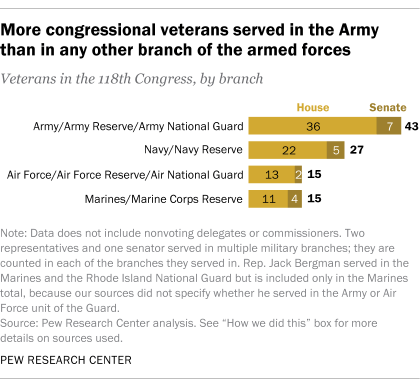The incoming U.S. House of Representatives will have 80 members who’ve served in the military at some level, or 18.4% of the total membership, according to a Pew Research Center analysis of this fall’s election results. That’s up from 75, or 17.2%, in the outgoing Congress. The number of senators who are veterans, 17, will stay the same.

Although 191 veterans won their parties’ nominations for House seats in 2022, only 80 of them won in the general election – and 62 of the victors were incumbents.
The next House will still have one of the smallest shares of veteran members in modern times. Between 1965 and 1975, at least 70% of members in each chamber had military experience, reflecting the mass mobilizations of World War II and the Korean War. (The first Vietnam War combat veteran elected to Congress, John Murtha of Pennsylvania, won his seat in 1974.)
While the sources consulted by the Center for this analysis aren’t always specific about when or where members served, it’s clear that most of the veterans in the new Congress are from the post-Vietnam era. Among all 97 House and Senate veterans who’ll be serving in the next Congress, 31 are in their 50s, 21 are in their 40s, and nine are in their 30s.
This analysis follows a more extensive look at veterans who ran for Congress or governor in the November 2022 general elections. In that earlier analysis, our main source for military service information for current and former members of Congress was the Biographical Directory of the United States Congress. For non-incumbents, we consulted a range of sources, including campaign websites, independent electoral information providers (including Ballotpedia and Project VoteSmart), the National Conference of State Legislatures and media reports.
We used these sources to determine each candidate’s gender and whether or not they identified as a veteran or claimed to have served in the military. For candidates who did claim veteran status, we noted which branch of the military they served in (Army, Navy, Air Force, Marine Corps, Coast Guard), which level or levels they served at (full-time active duty, reserve forces, National Guard), their years of service, their final rank, any specialty (such as JAG Corps, medical corps or Special Forces) and whether they had served overseas in an active combat role. Veterans who served in more than one military branch were counted in each of the branches they served in. Not all this information was available for every candidate. Our analysis does not include nonvoting delegates or commissioners.

More than three-quarters of veterans in the new House (62) are Republicans, while fewer than a quarter (18) are Democrats. On the other side of the Capitol, 10 of the 17 veteran senators are Republicans and seven are Democrats. In both chambers combined, all but seven veteran lawmakers are men.
The Army, including the Army Reserve and the Army National Guard, is the best-represented branch among the incoming group of senators and representatives with military experience.

More than 40% of all the veterans in the next House (36 of 80) served in the regular Army, the Reserve or the National Guard. That compares with 22 who served in the Navy or Navy Reserve; 13 who served in the Air Force, Air Force Reserve or Air National Guard; and 11 who served in the Marines or the Marine Corps Reserve. (Two members served in two different branches of the military; they are counted in each branch’s total. Rep. Jack Bergman, R-Michigan, served in the Marines and the Rhode Island National Guard but is included only in the Marines total, because our sources did not specify whether he served in the Army or Air Force unit of the Guard.)
Over in the Senate, seven senators and senators-elect served in the Army, Army Reserve or Army National Guard; five served in the Navy or Navy Reserve; four in the Marines or the Marine Corps Reserve; and two in the Air Force, Air Force Reserve or Air National Guard. One senator – Todd Young, R-Indiana – served in both the Navy and the Marines.
In this fall’s general elections, we counted 125 Republican House candidates who were veterans (47 incumbents and 78 non-incumbents), of whom roughly half (all 47 incumbents and 15 of the non-incumbents) won their races.
Of the 61 veteran nominees on the Democratic side (16 incumbents and 45 non-incumbents), all but one of the incumbents – but just three of the non-incumbents – won their races. All five of the independent and minor-party candidates we identified who were veterans also lost.
The Senate’s veteran membership will hold even at 17 next year, as four veteran senators won reelection and one retiring veteran senator (James Inhofe, R-Oklahoma, who served in the Army) was offset by one successful veteran candidate (J.D. Vance, R-Ohio, a former Marine). Ten of this year’s 35 Senate contests featured at least one veteran candidate; in the Indiana race, both major-party candidates were veterans.
